If you're passing, it's always worth dropping in to La Cocotte, the café at the Alliance Française in Kildare St., to check out the latest exhibition.
It's not the ideal exhibition space but with a little application and imagination you can get the message.
Anne-Sophie is a French woman, from Grenoble, who has lived in Ireland for the last six years. She's a photographer and her current dance project took her three years to assemble. The idea is to "portray a variety of traditional dances using the most famous Dublin landmarks as a background".
I hope Anne-Sophie will forgive me for bringing you my favourite five out of the dozen or more prints exhibited. Signed limited edition prints, A3 size, can be purchased. Email Anne-Sophie for details.
Oisín Kelly's Chariots of Life sculpture depicting the figure of a charioteer, said to represents reason controlling the emotions, is neatly captured with the fountain frozen over as background to this "Russian" ballerina.
This one is my favourite. Will he save her or just let her go? And Grand Canal Dock makes a great Swan Lake.
Stoney's diving bell encapsulates much of Dublin's dockland history and echoes the dancing "belle" in a neat visual pun.
Irish Piano Tuner will certainly be happy with this transport of delight.
I like the dancer echoing the verticals.
The exhibition closed on 1/3/2019.
Anne-Sophie's website
From the Alliance Anne-Sophie's exhibition migrated to the bespoke In-spire Galerie in Gardiner Street. With more space available in this dedicated premises the collection was expanded to show virtually all the photos in the project.
As you'll see from the above image, it opened on 7 March, and it runs till the closing night on 22 March when there will be a full evening's performance of 7 styles of dance plus, of course, the opportunity to see the photo collection.
Anne-Sophie welcomed a packed audience and after thanking all her collaborators told us about her motivation in putting the show together in the first place and some of her plans for the future.
There was much discussion in the course of the evening, with herself and between attendees, about the photos with everyone touting their favourite.
The Ha'penny Bridge must be one of the most photographed sites in town, day or night. The addition of the dancer here gives it a whole new, almost religious, perspective.
This photo is simply entitled Howth. Maybe a little scope for an extension specifying Ireland's Eye with its Viking and Napoleonic connections.
As if the exhibition itself wasn't enough, we were treated to some live dancing, including ballet (above) and belly-dancing (below). My lips are sealed.
And just to prove I was actually there and I wasn't the only one.
Update - 14 March 2019
Anne-Sophie wants to show Dublin at its best hence the choice of interesting locations for her photo shoots. She also wants to show the diversity of modern Dublin's inhabitants and this she is doing by including a variety of dance styles in the photographs. As an artist, she is combining the arts of dance and photography in this innovative project.
Above all she wants to share her enthusiasm and as part of this she organised a talk/tour of her current exhibition in In-spire Galerie.
In the course of this I learned a lot about Anne-Sophie as well as about her photos.
For example, she is not yet in a position to earn her living solely through her photography though she does sell signed limited edition prints, A3 size, of her photographs (Email Anne-Sophie for details). Hopefully, as her talent and creativity become more recognised she will be able to devote more time to her photography and make a living out of it.
At the moment she is constrained by having a "day job". This probably explains why many of her photo shoots are at weekends, though she points out that, while she prefers early morning shoots for the lighting, weekend shoots also mean that there are less people about.
People can be a problem for this type of photo. You simply want the dancer and the location, and you want this for an uninterrupted hour, the length of her typical shoot. She feels that anything longer than this will leave the dancer bored and he own creativity wilting.
When there are people about they vary in the degree to which they show respect for the shoot. In one location people showed no respect with the result that they were interfering with the shoot. With a limited time available this can be very frustrating.
In another location people showed too much respect. Anne-Sophie was hoping for a blurry effect of people passing by in the background but they all stopped and stood respectfully to one side admiring the shoot. You really can't win.
But you can strike lucky. On one shoot, and out of the blue, Anne-Sophie was offered full access to an out of service bus in the centre of the city. You can't beat that for luck and generosity. Again my lips are sealed.
Of course, you wouldn't know any of this from the excellent shots achieved on the day. I wouldn't know except Anne-Sophie told me, and the others present, and you wouldn't know except I'm telling you.
Limiting shoots to weekends also means that it takes longer to put a project together. The current one took all of three years to assemble.
A word on movement. While the photos are "posed" in the sense of the dancer performing at a given location, the actual shots are mostly arrested motion captured by the camera at a fast shutter speed, typically a thousandth of a second. In some cases, though, when she wants to show a trace of the motion, a fine judgement is called for in choosing the shutter speed.
Sometimes she has to be prudent in what she asks the dancers to do. For example, the terrain may not be the most suitable for a jump which would just make that shot. It is a matter of judgement on how far the dancer is asked, or is willing, to go on these occasions
So there is a lot of judgement involved and an important element in this is Anne-Sophie's rapport with the individual dancer. Although all the dancers are professionals they invariably respond in personal ways to this unique project.
Anne-Sophie discusses the project and the shoot with the dancer well in advance. In some cases the choice of location is suggested by the dancer as somewhere they particularly relate to. Examples here are Dublin 8 and the Japanese Garden in Camden Street. And the fact that Anne-Sophie heself was also a dancer for some years contributes enormously to building up the necessary rapport.
It's important to stress also that the photos are not Photoshopped. What she saw is what you get. This may involve some later adjustment of lighting or contrast to render a faithful shot but these are acceptable adjustments at the level of the overall photo.
Finally, in response to my asking, Anne-Sophie confirmed that she is to publish the collection in book form including a certain amount of background and description but not enough to take from the photos themselves, which are, after all, the story.
See the In-spire Galerie section of Anne-Sophie's website for other events taking place during the exhibition.

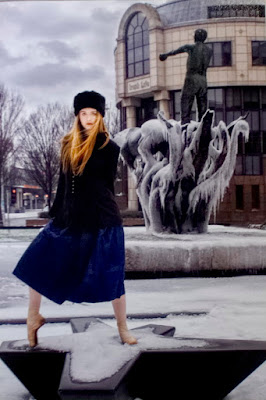


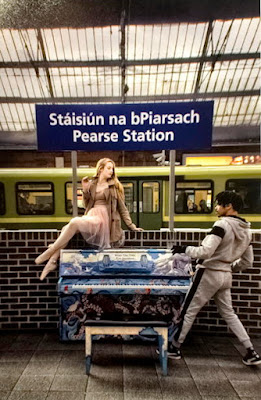
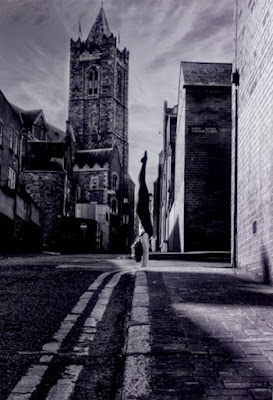
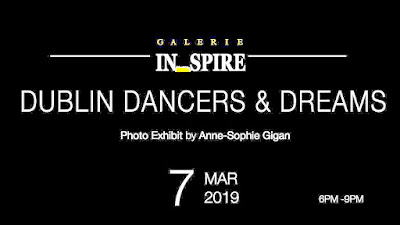
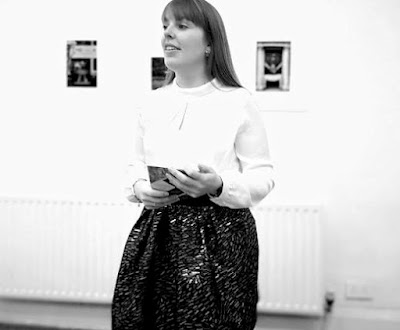

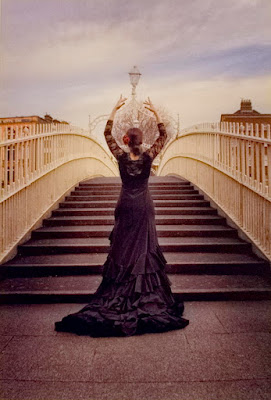









I had noticed that Anne-Sophie was from Grenoble. Now, in 1965 I stayed in Grenoble, actually in Crolles nearby, while on a French Government sponsored visit. I had got this while attending the Alliance for French classes. It was an excellent scheme called “Connaissances de la France” which introduced you to various aspects of French life.
ReplyDeleteWhile there, we visited a stunning church up the mountains in the village of St. Hugues de Chartreuse. I have recorded this on my website . Since Anne-Sophie was from Grenoble and in the arty world, so to speak, I thought she might be interested. I had no idea if she was even aware of the church.
Imagine my surprise when she replied that she knew it well as she had lived beside it. St. Hugues was her people's place. What an amazing coincidence.
I have had many contacts with France, the French, and their language, both personally and professionally over half a century. I had in mind sometime to document this, possibly in an illustrated talk, and there was a possibility at one stage that this might be at the Alliance, but that prospect has faded. I may yet find an excuse, this side of the other side if there is one, to inflict my musings on an unsuspecting public. Certainly, in the light of the above, St. Hugues will figure more prominently than first intended.